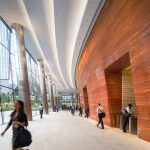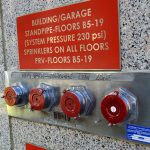How Does COVID-19 Challenge Future Engineering?
“Americans, on average, spend approximately 90 percent of their time indoors, where the concentrations of some pollutants are often 2 to 5 times higher than typical outdoor concentrations.” – U.S. Environmental Protection Agency[1]
Around the world, industries from every sector are banding together to find ways to take what we are learning from the COVID-19 pandemic to better our environments, societies, and lives. As engineers, we take our role in shaping the future of the built environment very seriously. We will need to continue to be patient and persistent as the future of engineering embraces a creative back-and-forth of sometimes competing forces.
How can we balance sustainability with healthy living?
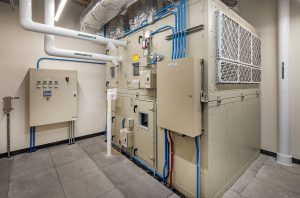 As engineering continues to advance, we keep looking for new ways to increase energy conservation to not only make more environmentally-friendly buildings, but to help building owners save money. However, COVID-19-related research has shown that transmission of the virus is more likely indoors, reinforcing the importance of fresh air exchange for the health of building occupants. As engineers, we must find a balance between health solutions and energy conservation, especially when some proposed design changes include options to run heating, ventilation, and air conditioning (HVAC) systems 24 hours a day, seven days a week. Other strategies to offset increased utility costs include using energy recovery systems.
As engineering continues to advance, we keep looking for new ways to increase energy conservation to not only make more environmentally-friendly buildings, but to help building owners save money. However, COVID-19-related research has shown that transmission of the virus is more likely indoors, reinforcing the importance of fresh air exchange for the health of building occupants. As engineers, we must find a balance between health solutions and energy conservation, especially when some proposed design changes include options to run heating, ventilation, and air conditioning (HVAC) systems 24 hours a day, seven days a week. Other strategies to offset increased utility costs include using energy recovery systems.
Increasing the amount of outdoor air coming into a building also increases the needs placed on heating and air conditioning systems. These systems require large amounts of energy to keep the indoor environment comfortable. With air constantly moving and changing out, it will take more energy than before to maintain a set temperature. This presents a special challenge as we continue to push buildings toward reducing carbon footprints. Commissioning, regular equipment checks, and maintenance can ensure that the building HVAC system is operating as efficiently as possible.
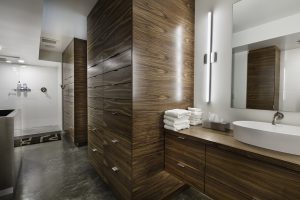 Water is another resource that continues to be a focus of conservation. Touchless faucets have been instrumental in reducing the amount of water wasted and germs spread from user to user. In today’s world, we must balance conserving water while increasing the minimum water discharge of touchless faucets to 20 seconds, as recommended by the Centers for Disease Control. While the amount of time must be increased slightly, solutions such as aerators can reduce water usage while maintaining a large enough spray coverage area to cover the hands.[2]
Water is another resource that continues to be a focus of conservation. Touchless faucets have been instrumental in reducing the amount of water wasted and germs spread from user to user. In today’s world, we must balance conserving water while increasing the minimum water discharge of touchless faucets to 20 seconds, as recommended by the Centers for Disease Control. While the amount of time must be increased slightly, solutions such as aerators can reduce water usage while maintaining a large enough spray coverage area to cover the hands.[2]
How does COVID-19 impact the layout of a building?
Design teams are always looking for ways to help provide cost-effective buildings. COVID-19 has brought attention to the benefits of having extra space to provide social distancing opportunities. Creating more spacious workspaces goes against the traditional ideas of cost-effective buildings. Once again, these seemingly opposing forces create an opportunity for design teams and building owners to come up with more innovative solutions and embrace new perspectives. This may mean designing workspaces with a natural six-foot radius between employees and reflecting that radius in design choices, such as the circles at the Cushman & Wakefield office.
Where does geographic location come into play?
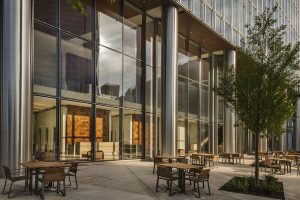 Many healthy building strategies rely on bringing outside air indoors and providing occupants with space to eat, work, and exercise outdoors. However, this becomes very difficult in global locations that have very poor to extremely poor outdoor air quality and more oppressive climates.
Many healthy building strategies rely on bringing outside air indoors and providing occupants with space to eat, work, and exercise outdoors. However, this becomes very difficult in global locations that have very poor to extremely poor outdoor air quality and more oppressive climates.
Poor air quality can come from sources such as smog or smoke from perennial wildfires and can make breathing difficult, even for healthy individuals. We can counteract some of the outdoor air’s pollutants as the air comes inside by upgrading the typical standard air filtration systems with high performance filters. These high performance filters can result in the removal of almost 40% more particulate matter.[3]
Location can also be a factor when considering physical and economic infrastructure surrounding a building. It is difficult to include healthy building solutions, such as advanced HVAC systems, if the building is not connected to an up-to-date and reliable power grid. Power grids and other infrastructure elements are directly dependent on the community’s economic infrastructure. As the socio-economic gap widens or narrows, so goes the opportunity to provide healthy buildings to our global communities.
Where can I learn more?
Follow the link to read more on the EPA’s “Report on the Environment.”
Read “What is the WELL Building Standard™?” and “What Does a WELL-Designed Building Look Like?” to find out how WELL can help create healthy buildings.
Works Cited
[1] United States Environmental Protection Agency. (2018, July 16). Report on the Environment: Indoor Air Quality. Retrieved August 25, 2020, from United States Environmental Protection Agency: https://www.epa.gov/report-environment/indoor-air-quality
[2] Duquesne University. (n.d.). Water Conservation. Retrieved August 25, 2020, from Duquesne University: https://www.duq.edu/Documents/green-industries/Conserving%20Water.pdf
[3] Bailes, A. (2018, November 9). The Unintended Consequences of High-MERV Filters. Retrieved August 26, 2020, from Energy Vanguard: https://www.energyvanguard.com/blog/unintended-consequences-high-merv-filters
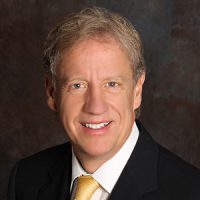
About the Author
Doug Alvine, P.E., LEED AP is a licensed electrical engineer and current president of Alvine Engineering. He has over 25 years of experience in the industry, working in diverse market sectors and incorporating sustainable design in buildings across the United States. He is proud to have worked on projects including the Northwestern Mutual Corporate Headquarters Campus in Milwaukee, River Point Tower in Chicago, and Fifth + Broadway Office/Residential Development in Nashville.



